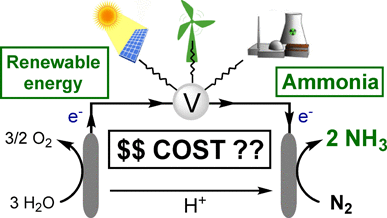当前位置:
X-MOL 学术
›
ACS Sustain. Chem. Eng.
›
论文详情
Our official English website, www.x-mol.net, welcomes your
feedback! (Note: you will need to create a separate account there.)
Potential Economic Feasibility of Direct Electrochemical Nitrogen Reduction as a Route to Ammonia
ACS Sustainable Chemistry & Engineering ( IF 7.1 ) Pub Date : 2020-05-25 , DOI: 10.1021/acssuschemeng.0c01206 Gal Hochman 1 , Alan S. Goldman 2 , Frank A. Felder 3 , James M. Mayer 4 , Alexander J. M. Miller 5 , Patrick L. Holland 4 , Leo A. Goldman 1 , Patricia Manocha 1 , Ze Song 1 , Saketh Aleti 1
ACS Sustainable Chemistry & Engineering ( IF 7.1 ) Pub Date : 2020-05-25 , DOI: 10.1021/acssuschemeng.0c01206 Gal Hochman 1 , Alan S. Goldman 2 , Frank A. Felder 3 , James M. Mayer 4 , Alexander J. M. Miller 5 , Patrick L. Holland 4 , Leo A. Goldman 1 , Patricia Manocha 1 , Ze Song 1 , Saketh Aleti 1
Affiliation

|
The Haber–Bosch process produces ammonia from hydrogen and nitrogen gases in a globally important energy-intensive process that uses coal or natural gas as a fuel and hydrogen source. Direct electrochemical ammonia synthesis from nitrogen and water using renewable energy sources presents an alternative to the Haber–Bosch process that would be more sustainable. Additionally, the different production structure of direct electrochemical nitrogen reduction technology suggests a supply chain alternative to the ammonia industry and a method for load leveling of the electrical grid. This alternative route to ammonia from dinitrogen would require smaller capital investments than the Haber–Bosch process and would not require a fossil fuel supply. The impact of dynamic electrical power pricing is analyzed for a system that could take advantage of pricing volatility. We show that, under certain scenarios, at achievable levels of energy efficiency with a future electrocatalyst, direct nitrogen reduction would be economically competitive or advantageous compared with Haber–Bosch-based ammonia production.
中文翻译:

直接电化学还原氮作为氨气的潜在经济可行性
哈伯-博世(Haber-Bosch)工艺在全球重要的能源密集型工艺中使用氢气或氮气产生氨,该工艺使用煤炭或天然气作为燃料和氢源。使用可再生能源从氮气和水中直接电化学合成氨,是Haber-Bosch工艺的替代方案,它将更具可持续性。另外,直接电化学氮还原技术的不同生产结构建议替代氨工业的供应链以及电网负载均衡的方法。从二氮到氨的替代路线比哈伯-博世工艺需要的资本投资更少,并且不需要化石燃料供应。针对可以利用定价波动性的系统,分析了动态电价的影响。我们表明,在某些情况下,在未来电催化剂可达到的能源效率水平上,与基于Haber–Bosch的氨生产相比,直接还原氮在经济上具有竞争优势或优势。
更新日期:2020-06-23
中文翻译:

直接电化学还原氮作为氨气的潜在经济可行性
哈伯-博世(Haber-Bosch)工艺在全球重要的能源密集型工艺中使用氢气或氮气产生氨,该工艺使用煤炭或天然气作为燃料和氢源。使用可再生能源从氮气和水中直接电化学合成氨,是Haber-Bosch工艺的替代方案,它将更具可持续性。另外,直接电化学氮还原技术的不同生产结构建议替代氨工业的供应链以及电网负载均衡的方法。从二氮到氨的替代路线比哈伯-博世工艺需要的资本投资更少,并且不需要化石燃料供应。针对可以利用定价波动性的系统,分析了动态电价的影响。我们表明,在某些情况下,在未来电催化剂可达到的能源效率水平上,与基于Haber–Bosch的氨生产相比,直接还原氮在经济上具有竞争优势或优势。











































 京公网安备 11010802027423号
京公网安备 11010802027423号